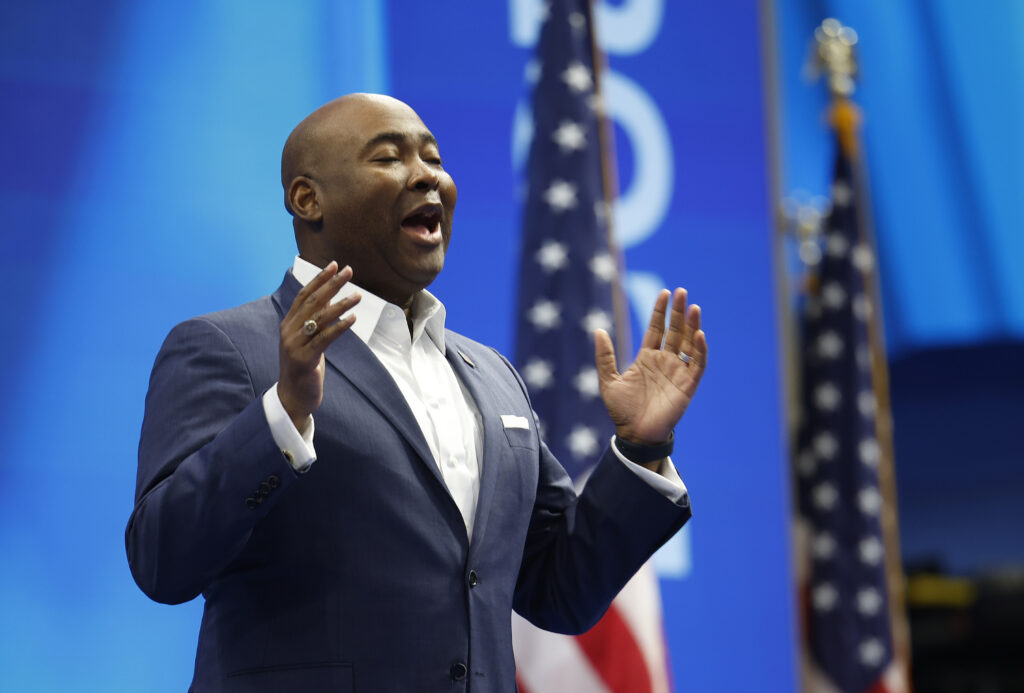Democratic National Committee Chair Jaime Harrison is funneling $75,000 to the Maryland Democratic Party to help in the Senate race here. Photo by Kevin Dietsch/Getty Images.
Still more national money is coming into the Maryland Senate election.
The Democratic National Committee will announce Friday that it is transferring $75,000 to the Maryland Democratic Party to help boost Prince George’s County Executive Angela Alsobrooks (D) in her race against former Gov. Larry Hogan (R).
The money is specifically being earmarked to support the state party’s mail program to engage Maryland’s Asian American and Native Hawaiian/Pacific Islander community. It builds on a $250,000 investment the DNC made previously to help support state party staffers who are working for Alsobrooks.
The latest investment may pale in comparison to the huge sums of money — millions of dollars — coming in on both sides of the race from outside sources, with more likely to come. But in a contest that’s considered close, even a five-figure investment can make a difference, particularly when it’s microtargeting a segment of the electorate as the latest DNC money is.
“The DNC is committed to electing Vice President Kamala Harris and Governor Tim Walz, Angela Alsobrooks, and ensuring Democrats have the resources to run competitive races across the map in red and blue states alike,” DNC Chair Jaime Harrison said in a statement.
“The investment we’re announcing today in the Maryland Democratic Party shows these priorities in action. Maryland Democrats will ensure working families can get ahead, while standing up to Trump and Republicans’ extreme agenda to rip away Americans’ most fundamental rights,” his statement said.
The money is part of $2.5 million in relatively small grants the national party is making to state parties to help in the final weeks of the 2024 elections. Maryland Democratic Party Chair Ken Ulman said the money from the DNC “will help us reach crucial constituencies.”
They can use the help. A Republican super PAC called Maryland’s Future has reserved $18.3 million of airtime and began running TV and radio ads this week that attack Alsobrooks for taking property tax breaks that she was not entitled to in Maryland and Washington, D.C. Alsobrooks has blamed those on accounting glitches and oversights, and vowed to pay any back taxes she owes.
In addition to that Republican investment, the political arm of EMILY’s List, the national organization that supports Democratic women candidates who support abortion rights, has already spent more than $4 million on ads attacking Hogan’s record on abortion.
Other outside groups may yet put a significant amount of money into the Senate election — a rare competitive federal race in Maryland. The latest poll on the race, released Thursday by The Washington Post and the University of Maryland, showed Alsobrooks with an 11-point lead.
The poll of 1,012 likely voters, taken Sept. 19-23, had Alsobrooks at 51% and Hogan at 40%. Libertarian Mike Scott had 3%, while 5% of the survey respondents had no opinion or preferred other candidates. The poll carried a 3.5-point margin of error.
Sixty percent of poll respondents said they want Democrats to retain control of the Senate, while 32% said they favored Republican control. Keeping the Senate blue has been a major argument of Alsobrooks and her allies, at a time when Democrats are clinging to a 51-49 advantage in the chamber and are expected to lose at least one seat in November, if not more.
Hogan has tried to convey to voters that the Senate is likely to flip regardless of what happens in Maryland, but that’s a nuanced argument. A key element of Hogan’s pitch to voters is that he will be independent of the national GOP if elected.
But the survey respondents weren’t necessarily buying: 46% said they expect Hogan would support the policies of GOP leaders if he joined the Senate, while 43% predicted he would act independently.
Hogan continues to face the headwinds of the presidential election in Maryland: 63% of the respondents in the Post/Maryland poll said they supported the Democratic nominee, Vice President Kamala Harris, for president, while 31% were for former President Donald Trump. If that trend holds, it will be challenging, though not impossible, for Hogan to attract a sufficient number of Harris voters to win.

